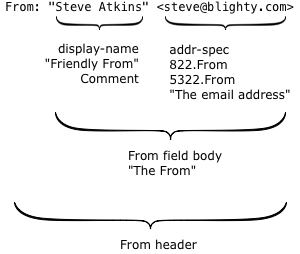Friendly email addresses
Most of the time when we’re talking about email addresses, we’re talking about the actual user@domain format that’s used to send mail over the wire, but that’s not how we most often see them. When they’re used in a To: or From: header they’re usually associated with a display name – the “real name” of the user with the associated email address. In the From: field that’s often called the “friendly from”, but the syntax used in the To:, Cc: and Bcc: fields is identical.
The display name is important, as it’s shown more in mail clients than the actual email address is. Some mobile clients don’t display the email address at all, just the display name.
There are three ways you can put an email address in a header field.
The best way is to wrap the email address itself in angle brackets, and put the display name in front of it.
To: Steve Atkins <steve@wordtothewise.com>
This is the right way to put an email address in a header. Always do this. If you don’t have display name leave that out – but still wrap the email address in angle brackets. It leaves no ambiguity about what part of the header is an email address.
If you don’t have a display name another valid option is just to include the bare email address.
From: steve@wordtothewise.com
This syntax is OK, and you’ll often see it in machine generated mail such as ad-hoc monitoring scripts.
The third syntax you’ll occasionally see is the email address followed by the display name in parentheses.
Cc: steve@wordtothewise.com (Steve Atkins)
Never do this. The text in parentheses isn’t really a display name at all, rather it’s a human readable comment. Many MUAs will display that comment as though it were the display name, but it’s not been the right way to include a display name at least since [rfc 822]RFC 822[/rfc] was released in 1982.
How about internationalized names?
All of these syntaxes consist solely of 7 bit ASCII characters. Using the first format you can include non-ASCII characters in the display name using [rfc 2047]RFC 2047[/rfc] MIME encoding. That’s the sort of encoding that looks like this, and is usable for any unicode character.
From: =?utf-8?Q?Steve=20Atkins?= <steve@wordtothewise.com>
As for the email address itself, you can’t universally use non-ASCII characters yet. Support for [rfc 6531]RFC 6531[/rfc] SMTPUTF8 is beginning to be deployed on readily available mailservers. And it is being supported by some google-hosted consumer ISPs, including blueyonder, cableone, ntlworld and gmail.
